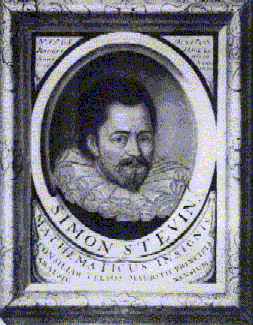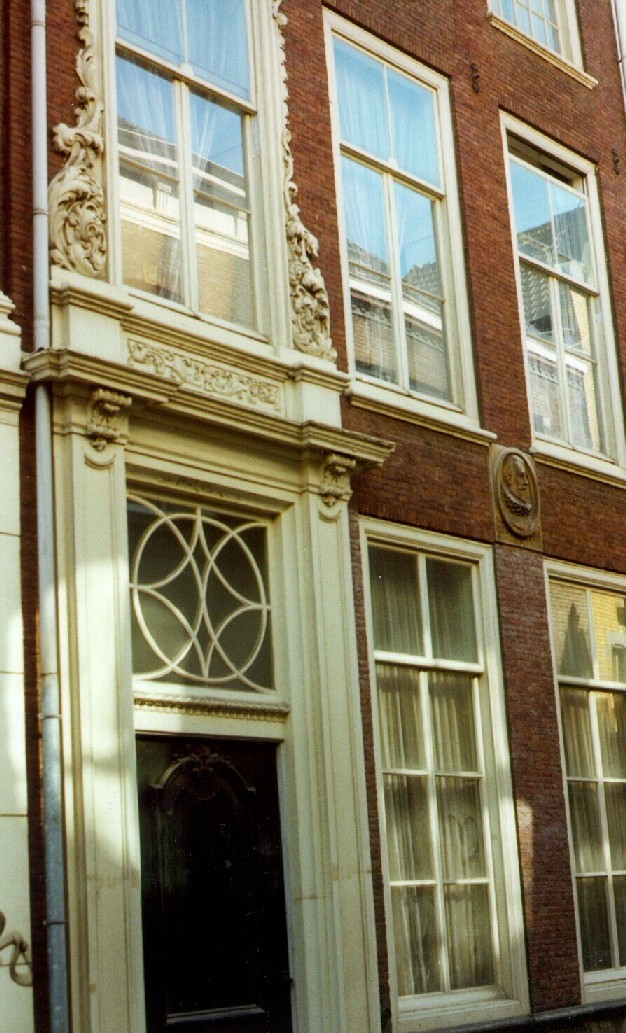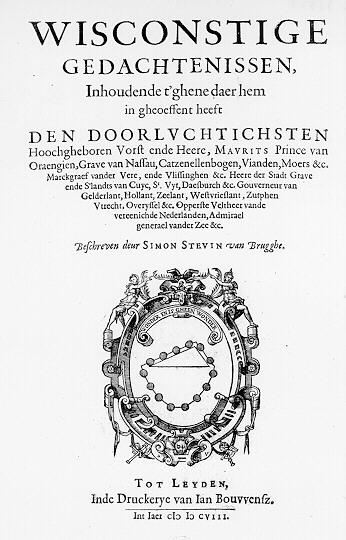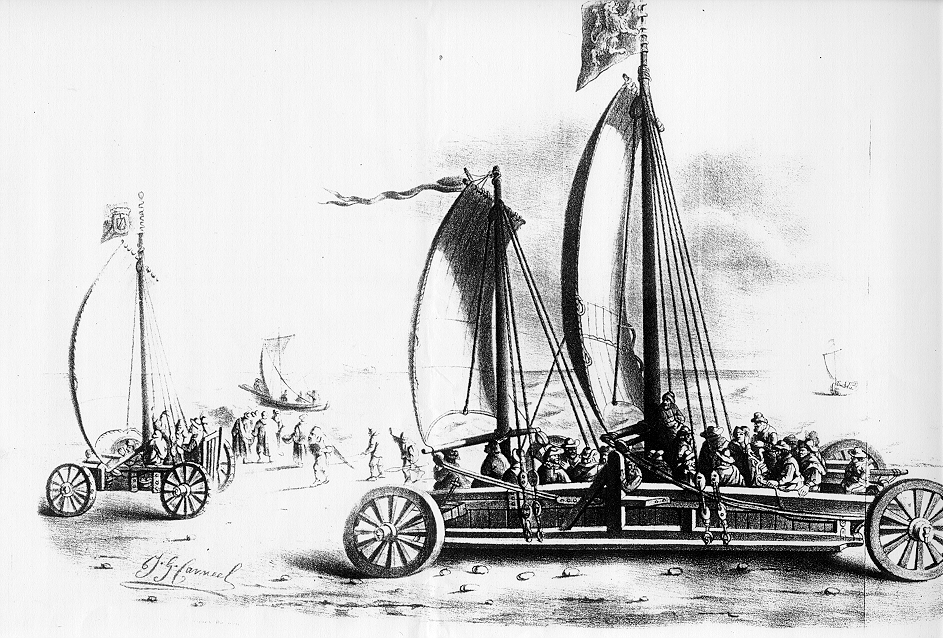Simon Stevin, Flemish tutor of a Dutch Prince
Portrait of Stevin (Library of the University of Leiden (The
Netherlands))

To a general educated public Simon Stevin is mainly associated with the introduction of the
decimal fractions, which laid later on to the
foundation of the decimal system of weights and measures. He realised a lot of
technical inventions out of which the construction of a 28-passenger sailing
carriage used along the seashore was best known to his contemporaries.
For those less familiar with Stevin we recall that he is born in Brugge (now Belgium) in 1548 as the
illegitimate child of Anthuenis (Anton) Stevin and Catelyne (Catherine)
van der Poort. Recent
studies proves that his father could be a cadet son of a burgomaster (mayor) of Veurne; his mother was the daughter of a burgher family of Ieper (Ypres), who married later
on a merchant in carpet-weaving and silk-trade, who belonged to a family with
sympathy for the Calvinism religion. Practically nothing more is known of Stevin's youth and education. He was at first employed in Antwerp as a
bookkeeper and cashier in one of the trading-firms; there he became acquainted
with business techniques. In 1577 he accepted a post at the financial
administration of the jurisdiction of Brugge ( Brugse Vrije).
A few years later he is registered at Leiden (now The Netherlands). The reasons
for this emigration, either his aversion for the Spanish oppression of the
southern part of the Low Countries, or his protestant sympathies, are
not certainly known. In 1583 we find him inscribed on the roll of the just
founded University of Leiden, where he made the acquaintance of
the young prince Maurits (Maurice) of Orange. A lifelong
friendship developed between the two men: prince Maurits
found in Stevin an excellent tutor and later a
capable and loyal counsellor; on the other hand Stevin
could always reckon on support and protection of his princely friend. Prince Maurits, elected in 1584 as stadtholder
of Holland and Zeeland, appointed Stevin in his personal service. Some sources quote Stevin as Quarter-Master General of the States' army (Staatse Leger). Recently one has discovered in the Public
Record Office (Rijksarchief) of The Hague a journal
and corresponding ledger, identified as an application in the year 1604 by Stevin of his ideas on "princely" bookkeeping,
containing as an entry Stevin's annual salary of 600
Dutch guilders. This high amount confirms the high status of Stevin at the court of the Prince. In 1600 Stevin founded on initiative of the Prince within the University of Leiden a school of engineering, where the
courses were taught in the Dutch (Nederduyts)
language. Several authors mention that Stevin has travelled a lot
trough Europe. Unfortunately there is only one known record of a visit to Dantzig (now Poland), where Stevin was invited to give his expert advice on harbour-works.
Around 1614 Stevin married young Catherine Cray; they
had four children: Frederic, Hendrik, Susanna and Levina. It was his second son, Hendrik
who published some posthumous work of his father. Stevin
died at The Hague between
February 20 and the beginning of April 1620, probably in his house at the Raamstraat,
he has bought in 1612 for 3800 Dutch guilders.
The house of Stevin in Den Haag (The Netherlands)

Stevin has some magic
with the general public in the Low Countries. A lot of
squares and streets are called after him. In his birth town, Brugge, the inauguration of Stevin's
bronze statue in 1846 gave occasion to great festivities. There exist numerous
Simon Stevin societies: one finds
-
Simon Stevin sailing clubs
in the Netherlands and in Belgium,
-
a student organisation Simon Stevin
for electromechanical engineers at the Technical University of Eindhoven,
-
several observatories, named after him,
-
a Simon Stevin foundation,
which has the objective to promote the study, the conservation, and restoration
of fortifications,
-
a Simon Stevin highschool for
architecture, health sciences and management
Furthermore we see the influence of Stevin today on several scientific organisations and
instances. There exists an international Simon Stevin
exchange program between eight departments for the history of science in the Netherlands, England and Northern
America. The "Stichting voor research and toepassing"
(the foundation for research and application) of the Netherlands award every year a prestigious Simon Stevin mastership to a prominent technical scientific researcher. On the BBC web
site, part education, four pages are devoted to Simon Stevin
in the section "local heroes". There existed a Belgian scientific
journal called "Simon Stevin, wis- en natuurkundig tijdschrift", (journal for mathematics and physics),
which became in present days the Journal of the Belgian Mathematical Society.
Simon Stevin is mentioned by prominent authors in a
list of approximately ten historical figures whose work, vision and technical
skill have made possible present day computers; he is cited in the good company of Pascal, Babbage, Hollerith, von Neumann, Zuse,
etc. In the famous Philadelphia list
"Printing and the Mind of Man", which highlights books which have had
an impact on the evolution of Western Civilisation Stevin's
"De Thiende" is
quoted. Only 65 books are withhold for the 16th
century. For the 400th anniversary of Stevin's birth in 1948 the Royal Academy of Sciences, Letters and
Fine Arts of Belgium devoted a whole number of its proceedings of 112 pages on
Simon Stevin.
Recently on the occasion of the 450th anniversary the Permanent
Commission of History of Sciences of this same academy organised a lecture by
Prof. R. Mertens, author of a contribution about Stevin in the National Biographic Dictionary of the
Academy, with title
"Simon Stevin, European Figure of
the Renaissance. In 1995 an exposition around the works of Stevin
was organised in the Biekorf, the town library of Brugge and in 1998 an exhibition about Stevin
was arranged by the Central Library of Gent University; works of Stevin belonging to the library were compared with those of
his contemporaries. The catalogues published on the occasion of these exhibitions give
a nice review of our present knowledge of the scientist. A Symposium
"Simon Stevin Bruggelinck" (Simon Stevin of Bruges) was held on
December 11 and 12 1998 in Brugge, organised by the
present authors and Dr. C. van den Heuvel (The
Hague). Specialists from the Netherlands, Denmark and Belgium expounded the
importance of Stevin for science in general and
technology.
Stevin is still the
subject of many publications in the last fifty years. It is not possible to
cite them all; we restrict ourselves to some important examples. One of the
most famous Dutch historians of science E.J. Dijksterhuis
produced together with some colleagues a very extensive study on the collected
works of Stevin, wherein a large part of the work is
reproduced, commented and translated in modern English. Dirk Struik, a Dutch professor of mathematics at MIT (USA) gives
his personal views on the science during the Golden Century, devoting an
important part to Stevin. The work "Geschiedenis van de wetenschappen
in België van de Oudheid
tot 1815", (The history of sciences in Belgium from the antiquity up to
1815, 1998) reports extensively Stevin's
works.
There still exists an important
interest for those contributions and endeavours of Stevin
which have been recognised as pioneering or influential since a very long time.
One of the first books Stevin published was "Tafelen of Interest" (Tables of interest, 1582), in
which for the first time in Western Europe
interest-tables were made public. Before that time only manuscripts were
available, of which copies were sold at very high prices to tradesmen,
merchants and bankers. It is without doubt that Stevin
introduced for the first time a complete description of decimal fractions and
the operations which can be carried out with them in a booklet, "De Thiende" (the Tenth, 1585). It also treats the
practical application of decimal fractions to the surveying of land, to the
measurements of weights and the partition of money. The English translation by
Robert Norton (London 1608), "Disme, The Arts of Tenths or Decimal Arithmetike",
has inspired Thomas Jefferson when he proposed a decimal monetary unit for the
new United States of America. The tenth of
the present dollar is still called a dime. The Scottish Laird and
mathematician, John Napier was inspired by Stevin's
work for the invention of logarithms. In his works on physics Stevin really introduced new original ideas. The study of statics of rigid bodies is exposed in "De Beghinselen der Weegconst" (Principles of Statics,
1585). It contains the fabulous "clootcrans"
theorem, an ingenious thinking experiment, by which the condition of
equilibrium of weights on an inclined plane is obtained. As a consequence of
this theorem Stevin succeeded in obtaining the sum of
two concurrent forces by the parallelogram rule. In "De Beghinselen des Waterwichts"
(Principles of Hydrostatics, 1586) Stevin gives an
improved demonstration of Archimedes' law, stating that a body immersed in a
fluid undergoes an upwards force. He also succeeds in calculating the force a
fluid exerts on the bottom of the vessel in which it is contained, which leads
him to the formulation of the so-called hydrostatic paradox, many years before
this was done by Blaise Pascal, to whom the paradox
is usually attributed. Stevin published in 1586 his
experiment in which two lead spheres, one 10 times as heavy as the other, fell
from the church tower in Delft (Holland) a distance of
30 feet in the same time. His report preceded by three years Galileo's first
treatise concerning gravity and by 18 years Galileo's theoretical work on
falling bodies.
Stevin was also a
great mathematician. As all scientist of the Renaissance he was active as
already shown in many disciplines. His innovating mathematical work dates from
1582 up to 1585. In that short period he calculates his interest tables; the
theory behind these tables is very clearly developed and explained. In his
"The Tenth" he introduced all operations - addition, subtraction,
multiplication, division and the calculation of square roots - on decimal fractions, a real novelty for that
time. In his work "L'Aritmetique" - the
only work written in French - he gives a review of the algebra knowledge of his
time. He introduces new ideas and new theories in algebra and describes a
numerical method for finding a real root of a function. In his "Problematum Geometricorum",
his only work written in Latin, the geometry, known at the end of the 16e
century is discussed. In his "Mathematical Memoirs" he gives a
pedagogically very well documented review of mathematics in general.
From 1590 on Stevin is more or less working in the service of Prince Maurits. The recent exhibition in the
"Rijksmuseum", Amsterdam entitled
"Maurits, prins van Oranje" is helpful in this regard and contributes to a
better insight in the Stevin-Maurits interaction. The
catalogue accompanying this exhibition describes a lot of details of this
relationship. It is a fact that most of Stevin's publications from 1590 on are devoted to subjects of interest
to his friend or to the nation. In 1590 he published a booklet "Vita Politica. Het Burgherlick
leven" (Civil life) in which he exposes how a
citizen as a good subject should comply with the rules of the authorities. It
was the time that the Republic of the Provinces of the Netherlands was organised
and with this publication Stevin aims at order and
regularity. In the same spirit Stevin published two
books of practical use for the defence of the country and the extension of the
fleet. In "De Sterktenbouwing" (The
construction of fortifications, 1594) the new way of fortification following
the Italian system was accommodated to the geographical conditions and the
available means of the Low Countries; in this way Stevin's
name remains associated with the so-called old Dutch method of fortification.
This book is probably used as course material in the engineering school. In the
second book, "De Havenvinding", (literally,
finding the harbour, in fact position finding, 1599) Stevin
describes the determination of a place on earth by the knowledge of the
geographical latitude and the magnetic variation of the needle of the compass.
This technique was of great importance for the ships of the "Verenigde Oost-Indische Compagnie" (VOC, United East-Indian Compagny), which has built up a monopoly position in the trade between
the (far) east and Western-Europe. In de
period 1605-1608 the lessons in the numerous sciences (algebra, geography,
astronomy, bookkeeping, physics, etc.) given by Stevin
to prince Maurits were collected and published as
"Wisconstige Gedachtenissen"
(Mathematical Considerations). Stevin's last
publications, dated from 1617, is a double book: in "Castrametatio,
dat is legermeting" he
describes the establishment and the furnishing of a well-organized military
camp; in "Nieuwe Maniere
van Stercktebou door Spilsluysen",
(New methods of fortification by spindle-sluices) he describes the use of this
special sluices in the defensive works, principally to keep the moats of a
desirable depth.
The "wisconstige gedachtenissen"

Besides the
well-known aspects of Stevin's work, nowadays the
less publicised contributions receive an increasing appreciation. In "De Spiegheling der Singconst" (Theory of the art of singing (music)), a
manuscript, recovered in 1884 by Bierens de Haan, Stevin was the first to
give a correct theory of the division of the octave into twelve equal
intervals. In the field of perspective, treated in "Van de beghinselen der Spiegelschaeuwen" (On the principles of mirror
images), and "Van de Deursichtighe" (On the
transparency) both parts of "Wisconstige Gedachtenissen" Stevin was
the first to build on the pioneering work of Guidoblad
del Monte; he contributed fundamental and new theorems regarding projections,
which are found under Stevin's name in mathematical
works of prominent
mathematicians. The influence of Stevins
concepts in the field of architecture, home building and town-planning receive
considerable attention. We find Stevin's ideas in
"de Huysoirdening" (Planning of the house)
and "Stedenoirdening" (town-planning)
included in the "Materiae Politicae,
Burgherlike Stoffen"
(Dissertations on political and civil affairs, 1649), published by Stevin's son Hendrik. This material is only a small part of a
project for a more elaborated book, planned by Stevin,
"Huysbou" (Building of houses), which was
never published. Parts of the hand-written manuscript of this "huysbou" were partially reproduced in the journal of
Isaac Beeckman and were recently discovered in the Rijksarchief (State Archive) of the province Zeeland (the Netherlands); they show
the importance of it for the history of the technique of civil architecture in Stevin' s
time.
The majority of
Stevin's works are published in his mother tongue,
the Dutch language. Stevin's goal was to bring
science and technology to the non-academic persons having no knowledge of
Latin, but possessing a certain understanding of science. In the introduction
of "De Thiende" he gives the categories of
people for which he wrote that pamphlet: stargazers, surveyors, carpet-makers,
wine-gaugers, mint-masters and all kind of merchants.
He extensively exposed his ideas about the Dutch language in his "Uytspraeck van de Weerdicheyt der Duytsche Tael"
( Enunciation about the dignity of the Dutch
language), written as an introduction to "De Weeghconst".
For Stevin the "Nederduyts"
was a pre-eminently language to express ideas, especially scientific thoughts,
because of its short words and the possibility of word combinations. Stevin's great merit has been that he has enriched the
Dutch language by the introduction of new words or combinations of known words
as translations of their Latin counterparts.
A typical example is the Dutch word for mathematics, "wiskunde" derived from "wisconst".
Stevin was highly esteemed by his contemporaries, but also by famous
scientists. This is clear from the writings of Isaac Beeckman,
Constantijn and Christiaan Huyghens and Adrianus Romanus (Adriaan van Roomen). The last one praised Stevin
for his statics and for his sailing-carriage. Beeckman has reproduced some of the Stevin's
manuscripts, which he has received from Stevin's
widow, in his journal. Hugo Grotius has showed a
great admiration for Stevin's work. Later on no one
less than Lagrange in "Traité de Mécanique analytique" and Feynman in
his famous "lecture notes" referred to Stevin's
work with admiration.
Sailing chariot
 [Published in an adapted form in Low Countries 10, 2002, 252-256 by J.T. Devreese (University of
Antwerp, Belgium) and G. Vanden Berghe (Ghent University, Belgium)]
[Published in an adapted form in Low Countries 10, 2002, 252-256 by J.T. Devreese (University of
Antwerp, Belgium) and G. Vanden Berghe (Ghent University, Belgium)]
